The Insider
Watch your words—and hands
June 7, 2011
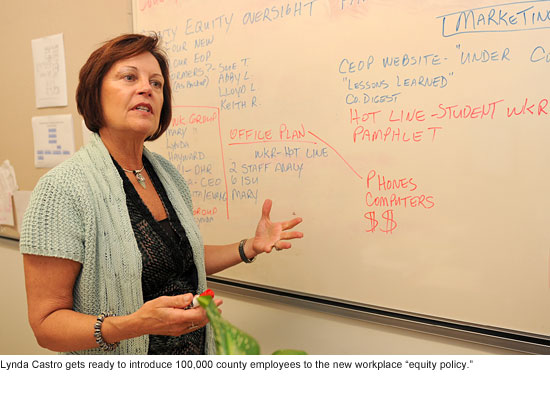 Hey, L.A. County employees, listen up. In case you had any doubts, there’ll be no leering, pinching, cat calls, unwelcomed advances or behavior that’s sexually, racially or ethnically degrading in the workplace. And those are just a few warnings specifically spelled out in the county’s new “Policy of Equity” for the first time.
Hey, L.A. County employees, listen up. In case you had any doubts, there’ll be no leering, pinching, cat calls, unwelcomed advances or behavior that’s sexually, racially or ethnically degrading in the workplace. And those are just a few warnings specifically spelled out in the county’s new “Policy of Equity” for the first time.
“Everyone is going to be held accountable,” says Lynda Castro, who, after three decades with the Sheriff’s Department, was lured out of retirement to oversee the county’s newly revamped approach to workplace harassment and bias. “If the employees treat each other with respect, then they’re more likely to treat the public in the same way.”
Hopefully, the public will also benefit by having to pay less in rising legal costs from lawsuits filed by employees, who’ve alleged sexual harassment or discrimination because of their gender, age, race or sexual orientation. “For risk management and liability concerns,” Castro says, “we have a policy with real teeth.”
At the heart of the new policy and process is the soon-to-be created County Equity Oversight Panel, comprised of four employment-law attorneys who’ll have full access to complaint investigations and, if need be, order further interviews. The panel will recommend discipline or other corrective actions and make sure there’s follow-through by the individual departments—sometimes a problem under the county’s previous, less centralized approach.
Between 2007 and 2010, the Office of Affirmative Action Compliance, which was previously responsible for ensuring compliance with the county’s harassment and discrimination policy, reported receiving 3,370 complaints. Of those, the office determined it had jurisdiction to pursue 2,110 under state and federal statutes.
The new county program, which will go into effect next month, was modeled after one that’s been in place since 2003 in the Sheriff’s Department, where complaints have been cut in half. Castro was a natural pick to serve as the oversight panel’s executive director because, until her retirement in 2009, she a key player in the sheriff’s efforts to reduce harassment and discrimination, including serving two years as chairperson of the department’s equity panel.
“This is a passion for me, an opportunity put a policy in place for 100,000 employees,” says Castro, 61, who was willing for now to sacrifice a life of traveling with her husband and catching her grandchildren’s soccer and basketball games. “There’s not a lot of things that would cause a retired person to come back to work.”
Posted on 6/7/11
Ups and downs at the Hall
May 24, 2011
 As everyone who hits a certain age is well aware, passing a 50th birthday can bring with it certain physical indignities.
As everyone who hits a certain age is well aware, passing a 50th birthday can bring with it certain physical indignities.
The county Hall of Administration, at 51, is no exception.
A recent spate of mishaps—including staffers getting stuck in elevators and a flood that doused three county supervisors’ offices—has brought some of the building’s maintenance challenges into sharp relief.
The county’s Internal Services Department, responding to a series of questions raised by supervisors at their May 17 meeting, explained that the water leak that flooded parts of the 2nd, 3rd and 4th District supervisorial offices on May 13 was caused by “routine maintenance work to replace heating and air conditioning water coils located above the 8th floor ceiling.” Maintenance routines are being reviewed to avoid a repeat performance.
As for those elevators, ISD responded to the supervisors’ publicly-aired gripes by rewiring the audible alarm system in the cars so that they now ring at the Hall’s 2nd floor sheriff’s station. Previously, the alarms could be heard only in the halls immediately outside the elevator. (The elevator cars also have “in-cab” telephones to reach the county operator.)
Routing the alarms to the sheriff’s station “should improve response time to entrapment incidents,” ISD director Tom Tindall said in a memo to supervisors this week. He also said the Hall’s 11 elevators, which include private elevators used by top county officials, are up to code and inspected regularly by the county, in addition to annual state inspections.
Some 2,700 county employees and several hundred visitors are in the Hall on any given workday. Since June 1, 2010, seven of them have reported getting stuck in the elevators, according to the county’s work order tracking system. And some of the unlucky seven have had VIP bosses.
“My staff member was stuck in there over an hour,” Supervisor Don Knabe said. Supervisor Michael D. Antonovich, who said his staff also had been stranded in the elevators in recent weeks, asked for a report on what it would cost to upgrade the elevator equipment at the Hall of Administration and the Stanley Mosk Courthouse.
“I know those of us who’ve served on jury duty…have a very difficult time getting to the court because you wait a lifetime for the elevator,” Antonovich said.
Estimates for replacing the elevator equipment will be submitted to supervisors by June 15, Tindall said.
Posted 5/24/11
Redistricting in your PJs
April 28, 2011
 Welcome to Redistricting, 2011—the home edition.
Welcome to Redistricting, 2011—the home edition.
This year, for the first time, Los Angeles County is giving the public the technological tools to create its own boundaries for the five supervisorial districts, using an impressive array of demographic and voting data to ensure each is drawn equitably.
“I’ve never seen this amount of information pulled together about the county on any website,” said Assistant Chief Executive Officer Martin Zimmerman, who is overseeing support staff for the redistricting effort.
The new do-it-yourself mapping feature is just one facet of a legally mandated undertaking that occurs every 10 years, following the federal census. The districts must be drawn to ensure fair representation on the Board of Supervisors, complying with the U.S. Constitution, federal Voting Rights Act, County Charter and California Elections Code. Each district must have an equal number of residents—roughly 2 million.
The board is expected to approve by August any changes to the existing boundaries, based on recommendations from the Boundary Review Committee, or BRC, whose members are appointed by the supervisors. A series of public meetings are now being held throughout the county. In the Third District, one will be held on Monday, May 2, at Van Nuys High School, and another will be convened on Monday, May 9, at West Hollywood Park Auditorium. Both will take place from 6 p.m. to 8 p.m. The BRC encourages public comment at these meetings and via e-mail through the county’s new redistricting website.
In preparing its recommendations for the Board of Supervisors, the committee also will study plans submitted by the public—a job that could be more challenging this time around.
Ten years ago, technology was far less sophisticated and accessible. Facebook billionaire Mark Zuckerberg was still in high school, for example, and dial-up Internet access remained popular in homes across America. Back then, the county installed mapping programs on computers it made available to the public at the Hall of Administration in downtown Los Angeles and at the county’s Public Works Department in Alhambra. Participation was not brisk.
But this time around, with the advent of high-speed connections and cutting-edge database technology, the county entered into a contract with a “geographic information systems” company called Esri to supply the software for home-drawn versions.
Given the depth and variety of information (there’s more than 20 racial breakdowns alone), county officials recommend that anyone interested in submitting their own redistricting plans should first participate in an online training session.
Even if you don’t want to submit a plan, the databases provide an unprecedented one-stop view of the county’s diverse cities and communities down to the census tract level, including not only race but also income, homeownership status, languages spoken at home, voting histories on past issues, party affiliation and gender, to name a few.
Said Assistant CEO Zimmerman: “It’s a treasure trove.”
Posted 4/28/11
Son of former supe an open book
April 1, 2011
 Novelist and poet Tom Schabarum says people had his dad all wrong.
Novelist and poet Tom Schabarum says people had his dad all wrong.
Yes, former Supervisor Peter F. “Pete” Schabarum famously locked horns with the gay community in the mid-1980s over funding for the rapidly escalating AIDS epidemic. But, Tom says, he was not anti-gay, as the critics alleged.
The son says he should know. Twenty-two years ago, while walking along the beach with his father in San Diego, he shared a secret.
“I came out to him,” Tom Schabarum recalls. “We talked for many hours. And he was great. He was awesome. He basically said, ‘This is not going to change our relationship,’ but in fact it did. It made it really, really good.”
These days, Tom is far removed from quiet talks on the shoreline. With his 50th birthday approaching, he’s now a Seattle writer whose debut novel, “The Palisades”, has just been named a finalist for a Lambda Literary Award, which recognizes gay, lesbian, bisexual, and transgender (LGBT) writing nationally. Last year, his poetry won the Creekwalker Poetry Prize, and this month, he completed a third work of fiction.
No, he laughs, none of it is subconsciously about his father. In fact, “The Palisades” began as an exploration of his relationship with his mother, Gerry, who died at 70 in 2007. He speaks several times a week to his beloved dad, who is now 82 and living near Palm Desert. He rarely discusses their relationship, he says, simply because for them, his coming out is “old news.”
“But I understand how it might come up,” he says, when asked. And for those who wonder how a gay son relates to a father whom gay activists once viewed as a public enemy, his response is ready: “My dad and I have always been great friends, and continue to be.”
Pete Schabarum was a Los Angeles County Supervisor for nearly two decades; a 640-acre wilderness park in the San Gabriel Valley is named after him. A real estate developer from Covina and one-time professional football player for the San Francisco 49ers, he was elected to the state assembly in 1966, then appointed by then-Gov. Ronald Reagan in 1972 to fill the First District seat of the late Frank G. Bonelli.
His tenure was a time of immense social change in Los Angeles County. By 1980, Reagan was in the White House, and the elder Schabarum was part of a conservative board majority. Small government was the watchword, but profound challenges were testing the county. In 1985, as activists became increasingly militant in their calls for more AIDS prevention funding, the state’s AIDS advisory board accused L.A. County of dragging its feet on a public health crisis. From now on, the board said, the state should give its money directly to community AIDS organizations rather than trusting the county to control the purse strings.
Offended, Pete Schabarum took aim at some of those local organizations, and when he denounced one particularly explicit safe-sex brochure as “plain, hard-core pornography,” the remark, picked up in Time magazine, turned the supervisor himself into a target. Positions hardened, and in 1989, after an especially noisy demonstration by AIDS activists in the board chamber, he angrily told them: “If you were to poll the man in the street, I think you would find the vast majority of the public really has no interest in the subject of AIDS and certainly could care less about the public financing the needed programs that you have articulated.”
 Such remarks, Tom Schabarum says, stemmed from outrage at the demonstrators, not from a lack of concern about AIDS. The younger Schabarum says 1989 was the year he came out, and the criticism “was a real bummer for me because I knew he wasn’t homophobic.”
Such remarks, Tom Schabarum says, stemmed from outrage at the demonstrators, not from a lack of concern about AIDS. The younger Schabarum says 1989 was the year he came out, and the criticism “was a real bummer for me because I knew he wasn’t homophobic.”
Two years later, demographics eclipsed that battle. As pressure built in L.A. for more diverse representation, a court ordered redistricting gave Latinos a greater voice in the selection of a supervisor. As a result, Pete Schabarum retired from his First District seat and was succeeded by current Supervisor Gloria Molina.
“I think my dad was a politician for noble reasons,” says the younger Schabarum. “Whether he was conservative or liberal doesn’t make any difference—he wanted to do good.”
Growing up, he says, his father’s support was a given. When Tom, at 20, caught the photography bug, he says, his father never questioned his request to transfer from the University of Utah, where he was an English major. “I don’t know what my parents said to each other, but when I said, ‘Hey, Dad, I want to go to photography school, he just said, ‘Okay’.”
The younger Schabarum eventually earned a bachelor’s degree in cinematography from the Brooks Institute of Photography in Santa Barbara and went to work for firms that stage live corporate events such as sales meetings and product launches. He is still a freelance creative director and producer with clients ranging from banks to major tech companies.
But writing remained a passion, and in the early 1990s, he says, he began his first novel, a family drama about a gay son and his vagabond mother in Big Sur.
“The book stemmed from wanting to connect with my own mother, but it’s not autobiographical at all—in fact my mother is not even in the book and Nicholas [the gay character] bears no resemblance whatsoever to me.”
He worked on it, he says, during a workshop taught by L.A. author and former USC instructor John Rechy, and when he finished after four years, “I put it in a drawer and started another novel.” That book, “The Narrows, Miles Deep,” depicted another family, this time during the AIDS crisis, and it went into the drawer, too.
“I was writing for myself—I never felt like I was writing to publish,” he says. In fact, “The Palisades” stayed in the drawer for 12 years, through a third novel, countless poems and an MFA in creative writing from Bennington College.
“But then I went through a midlife crisis or whatever, and decided that if I wanted to be viewed as a writer, I needed to put my work out there,” he says. One day, he described the manuscript to a writer friend in Seattle, and, on the friend’s advice, decided to test the waters by self-publishing on Kindle in the hope of attracting a mainstream publisher’s attention.
The result was the announcement last month that “The Palisades” has been named a finalist in the category of gay debut fiction. (The poem below is available in the upcoming issue of “Poet Lore” magazine.) “I’m finally coming out—as a writer,” he says, laughing.
“I have so many more stories to tell.” The awards will be presented May 26 in New York.
Posted 3/30/11
Grandparents beware…
March 31, 2011
 One of the best things about technology is the way it can keep families connected. But in recent weeks, consumer agencies have issued a warning:
One of the best things about technology is the way it can keep families connected. But in recent weeks, consumer agencies have issued a warning:
Grandparents beware.
A longstanding wire fraud scam has been taking a national toll on loving relatives, particularly seniors, to the point that authorities in recent week have decided to make an all-out assault on it.
“It’s become a big issue,” says Rigo Reyes, acting director of the Los Angeles County Department of Consumer Affairs. “Last year, the Federal Trade Commission got over 60,000 complaints on it.”
Here’s how it works:
A senior citizen gets an urgent call, email or Facebook message from someone claiming to be a police officer or an adolescent grandchild. The message says the grandchild has been hurt or arrested or is otherwise in trouble, and needs hundreds or thousands of dollars to be wired immediately via money order or Western Union. And one more thing: Don’t tell mom and dad.
“The grandparents don’t want anyone to be in trouble, so they wire the money without checking first with other family members,” says Reyes. “In one case, the grandmother told the caller, ‘You don’t sound like my grandson,’ and the guy said ‘I broke my nose in a car accident, so I sound different’.
“But in many cases, the crooks can fool you because they hack into Facebook accounts and get enough information about the family to drop names and birth dates and so forth. They get marketing lists with specific details, names and addresses.
“They can be convincing, but once that money is wired, it can be picked up by anyone with a password — and good luck getting it back.”
The Department of Consumer Affairs and the Consumer Federation of America offer these suggestions for seniors to avoid being scammed:
–Always check with other family members if you get an SOS from a family member.
–Be proactive. Create a family code word to signal emergencies to each other
–Never wire money without being absolutely sure of the recipient and the reason.
And this goes for you, too, Mom and Dad.
Posted 3/31/11
Masters of ceremony
March 9, 2011
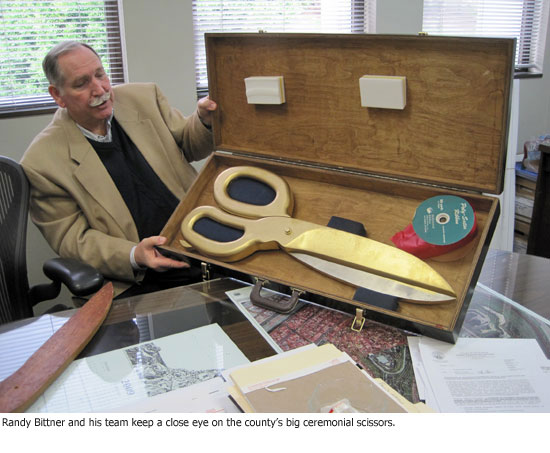 Every time a Los Angeles County dignitary grins into the camera and cuts a big red ribbon, somewhere up there Arthur “Ski” Wisniewski is smiling, too.
Every time a Los Angeles County dignitary grins into the camera and cuts a big red ribbon, somewhere up there Arthur “Ski” Wisniewski is smiling, too.
Back in the early ’80s, Wisniewski, a carpenter and manager in the Internal Services Division, ushered in the county’s modern era of ceremonial snipping when he handcrafted a pair of immense solid wood scissors with sharp metal blades that actually cut.
Of the five original pairs (one for each supervisorial district), only two remain in service. They’re closely guarded implements, ferried to events in custom-crafted cases and quickly packed away once the TV cameras have gone home.
“We have to more or less guard them now,” says Randy Bittner, ISD’s section manager for facilities operations services, who keeps the scissors locked up when they’re not in use. “The guys never take their eyes off them.”
“The guys” are ISD’s special events section—the backstage crew for virtually every public event staged by a county supervisor or department anywhere in L.A. County.
If ceremonial events provide a symbolic narrative of government work in action, these guys are the story’s unsung ghost writers.
They work out of a hangar in East Los Angeles equipped with a carpentry room and well-stocked with folding chairs, tables, lattice backdrops, tents, gold-painted shovels (for groundbreakings) and even a couple of ice machines.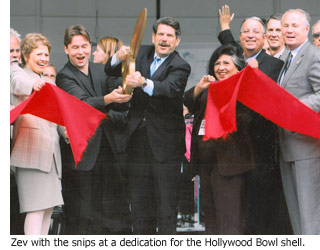
You get the feeling that, given a cake and a deejay, these guys could stage a pretty good wedding reception if they had to. It hasn’t come to that, but they have set up events ranging from hospital wing openings and park gymnasium groundbreakings to postage stamp unveilings and supervisorial trail rides. They created an impromptu “green room” for Seal when he performed at the county’s Rancho Los Amigos National Rehabilitation Center. Their carpentry work ranges from ADA-accessible walkways to those oak podiums featuring the county seal, regularly seen at press conferences on the nightly news.
“We see our programs on television all the time. I tell my wife, ‘I built that,’ ” says Sylvester “Sly” Anthony, the team’s carpenter supervisor.
As for the scissors, the ISD team oversees a dry run before each event to make sure the ceremonial cut takes place without a hitch. (The advice is always the same: Make sure the ribbon is pulled taut.)
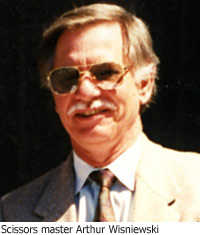 Even though the scissors are as tall as a toddler, they are surprisingly easy to use. Despite being pressed into service at hundreds of events over the years, they’ve held their edge without any special maintenance.
Even though the scissors are as tall as a toddler, they are surprisingly easy to use. Despite being pressed into service at hundreds of events over the years, they’ve held their edge without any special maintenance.
“It’s not like trimming hedges,” Bittner says.
In recent years, they’ve helped to inaugurate projects big and small, including the new County-USC Medical Center, the new emergency room at Olive View-UCLA Medical Center, the Department of Public Social Services’ mobile food stamp sign-up van and a fitness zone at El Cariso Park in Sylmar.
By all accounts, creating the scissors was Wisniewski’s idea.
“I believe he took it upon himself. He just wanted a better, more impressive pair of scissors,” says Paul English, ISD’s division manager of craft operations.
Wisniewski’s decision to equip his creation with a working blade automatically elevated them above the props widely used elsewhere—the ones that look good for the cameras but can’t shear through even the flimsiest ribbon.
“Most of them don’t cut,” English says. “I’ve never seen one with an edge.”
Wisniewski got to see his scissors in plenty of action before he retired in 1997 after 35 years of county service. He died last year, but his scissors remain on active duty—as sharp as ever.
“We like ‘em,” English says. “They’re visually impressive.”
Our new man in Sacramento
February 2, 2011
For more than a decade, Los Angeles County’s point man in Sacramento has been one of the oldest hands in the state capitol. When Dan Wall announced his retirement late last year as the top lobbyist for the county, he was capping a 37-year resume that dates to Ronald Reagan’s gubernatorial administration. Wall isn’t joking when he says he’s been lobbying since the first time Jerry Brown was governor.
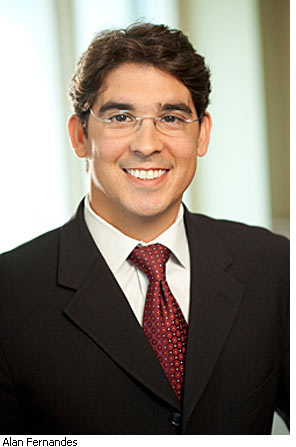 So filling his shoes was no easy task, says Assistant Chief Executive Officer Ryan Alsop. “We searched for months and months.” And Alsop found his man just in time for a budget season that promises to be of historic importance.
So filling his shoes was no easy task, says Assistant Chief Executive Officer Ryan Alsop. “We searched for months and months.” And Alsop found his man just in time for a budget season that promises to be of historic importance.
Alan Fernandes, come on down.
Fernandes, a 36-year-old lawyer and father of two from Davis, comes to the county from the well-known Sacramento law firm of Nielsen, Merksamer, where he has represented public sector clients for nearly 10 years.
With a bachelor’s degree in political science from UC Davis and his law degree from the McGeorge School of Law at University of the Pacific, he is currently the lobbyist for San Diego, Riverside, Contra Costa and Marin counties. He also has served on the Business and Economic Development Commission for the City of Davis, where he not only helped turn the city’s collection of rare and antique bicycles into the California Bicycle Museum, but also helped the city land the formerly New Jersey-based U.S. Bicycling Hall of Fame.
“Alan will be a great asset to the county in Sacramento,” said Alsop, who lauded Fernandes’ “honesty, knowledge, great work ethic and communications skill.”
And he’s going to need every ounce of that talent.
With California facing a $25.4 billion budget gap, Gov. Jerry Brown has proposed transferring the cost of many services from the state government to the counties, offering local governments more autonomy, but also potentially leaving them with much greater financial obligations that might not be underwritten in the long term.
Los Angeles County, for example, has estimated that Brown’s realignment plan could force it to absorb many millions of dollars in new costs and overwhelm the county’s already over-crowded jail system.
“I think we’re at a point where the restructuring of the state and local relationship is needed,” Fernandes said, speaking by phone between capitol meetings. “If it’s done right, it can actually serve the residents of California a lot better. But if done wrong, it could actually set us back even further—if that’s even imaginable.”
 Fernandes called the most recent election “one of the most important in California since Proposition 13. “The results are going to put us in situations via realignment that could restructure government,” he said. “I applied for this job because I want to be a part of that.”
Fernandes called the most recent election “one of the most important in California since Proposition 13. “The results are going to put us in situations via realignment that could restructure government,” he said. “I applied for this job because I want to be a part of that.”
But, he added, he also applied because Los Angeles County is in a class by itself as a player in Sacramento. “Los Angeles is a third of the state, at least.”
That’s high praise coming from a Northern Californian. In the interest of full disclosure, however, Fernandes did admit one potentially serious conflict:
“I’m going to be completely up-front,” he confessed, laughing. “I’m a big San Francisco Giants fan.”
The appointment to the $175,000 a year post is expected to become official on February 10. After a transitional period, Wall, 64, will finally retire.
“I have projects,” said Wall, who, in true county fashion, lives in unincorporated Sacramento County. “I have a 1961 Triumph TR 3, a little red sports car, and I’m going to put that in working order. I’m going to do a little wine cellar at home because I like wine. I want to play the guitar. And we want to go to Italy, my wife and I. I think after 37 years working in this process, it’s time for a little change of view.”
Calling all construction lookie-loos
January 27, 2011

As every schoolchild knows, it’s nearly impossible to walk by a construction site without stopping to peek through the fence and watch the hard hats and heavy equipment at work. Now county photographers are making it easy for the public to peer through a virtual fence and check out the progress of the Civic Park as it takes shape outside the county Hall of Administration.
New photos are being posted each month on the Civic Park website, which also includes construction updates, news about traffic detours and parking and renderings of what the project will look like when it’s scheduled to be completed by the summer of 2012.
The park, which broke ground last summer, is on schedule despite the record winter rains, says Dawn McDivitt, a capital projects manager in the county’s Chief Executive Office who’s been overseeing the building effort. “It was a huge challenge, and [the contractors] came to the table and have been very accommodating.
“I can’t say enough about how smoothly everything is going.”
Workers have wrapped up much of the demolition and now can begin the building phase.
When completed, the 12-acre park will provide a green oasis stretching from Grand Avenue at the Music Center to Spring Street at City Hall. The four-level park will feature amenities including performance lawns, ADA-accessible walkways, a community terrace area showcasing plants from around the world and a restored historic Arthur J. Will Memorial fountain, complete with a new wade-able membrane pool.
The county workforce, McDivitt says, has been “extremely patient and very inquisitive” about the park construction in their midst.
“Out of all of our capital projects, it is one of the most exciting things that’s been happening, having it in our own backyard.”
Posted 1/27/11
Checking for county cell phone static
January 4, 2011

With more than 17,000 cell phones, Blackberries and other mobile communications devices out there in the hands of Los Angeles County employees, supervisors sent a loud and clear signal to department heads Tuesday:
Look who’s talking—and make sure that the public isn’t being stuck with any unwarranted roaming, texting, directory assistance and other service charges.
On the heels of an audit that found widespread cell phone abuse and lax oversight in the Department of Children and Family Services, supervisors voted to initiate a countywide policy to make sure proper controls are in place across the county’s entire mobile communications network. There currently is no centralized oversight of the county’s cell phones; instead, that responsibility falls to individual departments.
It’s a big responsibility—and it’s growing. An inventory of handheld communication devices by the county’s Chief Information Office forecasts that the number of cell phones and similar devices being used by county workers will grow from 17,657 this fiscal year to 19,304 in the next one.
Supervisors, acting on a motion by Michael D. Antonovich and Gloria Molina, on Tuesday directed all county department heads to conduct internal reviews of their cell phone control practices and report back on whether they found any issues similar to those that turned up in the DCFS audit.
That probe found at least $514,000 in potentially inappropriate charges as well as 250 cell phones whose users could not be identified and 1,400 cell phones that were running up monthly service fees even though they weren’t being used. One employee racked up more than $2,000 in personal international calls but did not reimburse the department, while another’s phone was linked to $8,000 in service charges, including roaming charges from Mexico. Still another employee ran up $2,827 in texting charges over the course of a year.
DCFS reported a combined total of 3,699 cell phones and Blackberry/PDA devices in the Chief Information Office’s inventory—nearly 21% of the county total. The department spends about $2.2 million a year on its cell phones. The county’s overall spending on mobile devices could not immediately be determined. A Chief Executive Office analysis to determine whether the county would save money by giving employees a stipend for cell phones, instead of paying the bills directly, was launched before the DCFS audit came out but has not been completed.
The motion passed by supervisors on Tuesday also directed the county Auditor-Controller, which conducted the DCFS audit, to cast its net more broadly in the next 12 months to ensure that various county departments have enacted cell phone policies and controls and are complying with them. And it asked for a progress report in 30 days on how the DCFS is progressing on implementing reform recommendations spelled out in the Auditor-Controller’s audit.
Posted 1/4/11












 405 bridge work causes a stink
405 bridge work causes a stink
